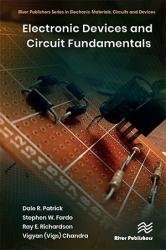 Название: Electronic Devices and Circuit Fundamentals
Название: Electronic Devices and Circuit FundamentalsАвтор: Dale R. Patrick, Stephen W. Fardo, Ray E. Richardson, Vigyan Chandra
Издательство: River Publishers
Серия: River Publishers Series in Electronic Materials, Circuits and Devices
Год: 2023
Страниц: 1079
Язык: английский
Формат: pdf (true)
Размер: 61.7 MB
This book explores many fundamental topics in a basic and easy-to-understand manner.
The chapter "Semiconductor Fundamentals" deals with the theory of materials that are used in the construction of electronic devices called solid-state. Solid-state devices are made of semiconductor material. You may recall from your studies of DC and AC electronics that a semiconductor is a solid material that has electrical properties that lie somewhere between those of a conductor and an insulator. Semiconductors have made possible such things as radio, television, computers, robots, smart phones, and electronic sound systems. Semiconductor theory focuses on the flow of current carriers through semiconductor material. A basic understanding of semiconductor theory will enable you to understand the electrical characteristics of solid-state devices and how they operate.
P–N junction diodes are used rather extensively in the field of electronics. Radio, television, industrial control, computers, home entertainment equip ment, and electrical appliances are a few of the applications. Diodes are probably the simplest of all electronic devices because only two leads, or electrodes, are used in their construction. In general, diodes are used to control the conduction of electric current. Functionally, diodes are unidirectional, which means that they conduct well in only one direction. Diodes, therefore, are designed to block or pass current according to the polarity of voltage applied (biasing). This permits the diode to be used as a switch. Diodes can also be used to alter the direction of current passing through other electronic parts. In this application, the diode is used to change AC to DC, a process called rectification.
The expression integrated circuit, or IC, is a generic term used to describe a group of small electronic components that are constructed and permanently interconnected on or in a piece of semiconductor material called a substrate. Integrated circuits (ICs) are actually micro-miniature circuits. Each may contain resistors, conductors, semiconductors, capacitors, and, in some cases, inductors in a single package. The components are classified as either active or passive. Active components are semiconductor devices such as transistors and diodes. Passive components are resistors, capacitors, and inductors. These components perform the same job that they do in a conventional circuit; however, they do not have the same general appearance when housed in an IC.
Two general classifications of ICs are linear and digital. Linear ICs are used to achieve amplification, regulation, and voltage comparisons. Digital ICs contain switching circuitry of which input and output voltages are limited to two possible states: high and low. The output of a digital IC is related to the input in some logical way. Digital ICs include logic gates, flip-flops, counters, clock chips, calculators, memory, and microprocessors.
This book has been expanded to 22 chapters, further simplifying content and providing a more comprehensive coverage of fundamental content. The content has been continually updated and revised through new editions and by external reviewers throughout the years. Additional quality checks to ensure technical accuracy, clarity and coverage of content have always been an area of focus. Each edition of the text has been improved through the following features:
• Improved and updated text content
• Improved usage of illustrations and photos
• Use of color to add emphasis and clarify content
Electronic Devices and Circuit Fundamentals is appropriate for use with the following: Post-secondary technical programs, including colleges, universities, and community colleges, High School (11th and 12th grades) technical programs, business, and industry training programs or for individual self-study to learn about the exciting engineering/technology areas of electronics.
Скачать Electronic Devices and Circuit Fundamentals